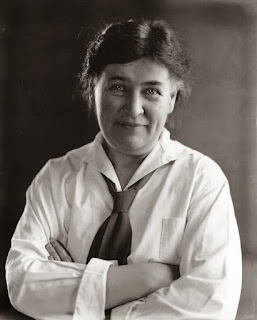It’s approximately the late 1870s-early 1880s. Marian Forrester is married to Captain Daniel Forrester, one of the pioneers of the Western Territories and a man known for his work in building railroads. They live in the small town of Sweet Water, in a state like Nebraska. Their large house is situated outside of town, topping a large hill and including a considerable amount of surrounding acreage, with orchards, streams, marshland, and pastureland.
Every boy in town is in love with Marian, including the narrator of A Lost Lady by Willa Cather (1873-1947). Neil Herbert is 11 when the story begins and part of a group of boys seeking permission to picnic near the marsh. What he sees in Marian in a woman 25 years younger than her husband, full of life and kindness, a woman who inspires admiration and envy. But she’s also a woman of her time, epitomizing her time but also somewhat rebelling against it. And her time is passing.

Willa Cather
We see Marian always through Neil’s eyes, and eventually she’ll come to disappoint him. But he never stops loving her, even as her fortunes (and her husband’s) wane and decline and even as she comes under the influence of Ivy Price, a young man who might have inspired William Faulkner’s Flem Snopes. Price will feast on the bones of the older generation, caring nothing, always on the make.
Very much of its time (published in 1923), A Lost Lady is also a timeless story of passing generations, the West and how it changed, a boy and young man’s deep feelings for a much older woman, and the woman herself, embodying the spirit of the age and the rebellion within that spirit.
In addition to poetry and short stories, Cather’s works include O Pioneers! (1912), My Antonia (1918), The Professor’s House (1925), Death Comes for the Archbishop (1927), Shadows on the Rock (1931), Lucy Gayheart (1935), and Sapphira and the Slave Girl (1940). She received the Pulitzer Prize for Literature for One of Ours (1922). A native of Virginia, she moved with her family to Nebraska in 1882, and many of her stories and novels are set there. She graduated from the University of Nebraska in 1895, worked as a journalist and teacher in Pittsburgh and New York City, and began publishing in 1903. By 1912, she’d become a full-time writer. Originally marginalized as a regional writer, she’s now considered one of the greatest American novelists of the 20th century.

No comments:
Post a Comment